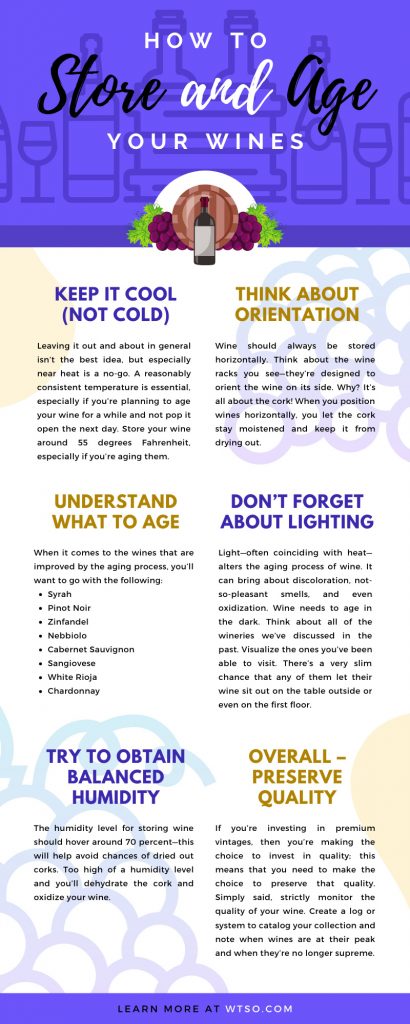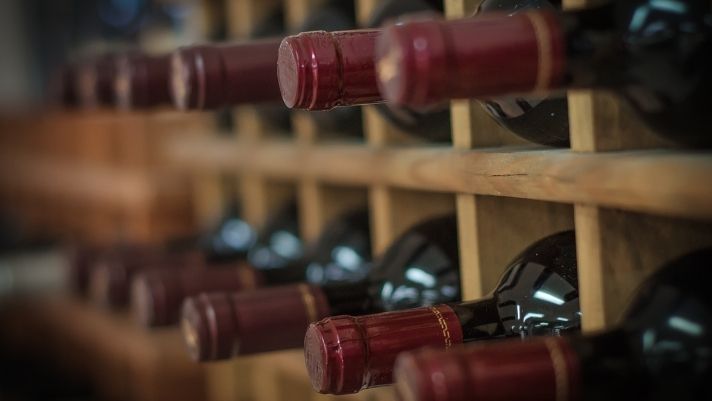The wine we choose to have in our household deserves to be well taken care of. This means that leaving it in the trunk of our car in the summer or freezing in the garage during winter may not be the best choice. If you’re holding onto some fancy bottles, then you’ll want to ensure proper storage. To help you figure it all out, we’ve created a guide on how to store and age your wines, so that no matter when you’re ready to open a bottle, it’ll be fresh and ready to go!
An Important Reminder: If you want successful storage and aging, then you’ll want to begin with wines that have yet to be opened. Wine oxidates over time, and uncorking the bottle allows too much oxygen to penetrate the liquids even if you follow all of our tricks below.
Keep it Cool (Not Cold)
Leaving wine out and about isn’t the best idea, especially near heat. A reasonably consistent temperature is essential, especially if you’re planning to age your wine for a while and not pop it open the next day.
Age your wine in a cool area to keep it from spoiling. Your kitchen is not a safe place to store your wine. It’s a place full of varying temperatures, which makes it quite difficult for wine to age correctly. If you’re serious about your wine collection and the aging process, then it’s even better to store the bottles in a dedicated wine refrigerator. It’s the perfect choice for those of us who don’t have a basement that doubles as a wine cellar—and even then, most basements don’t provide adequate conditions of a true wine cellar!
Pro Tip: Store your wine around 55 degrees Fahrenheit, especially if you’re aging them.
Don’t Forget About Lighting
An aspect that plays a role in the temperature of your wine is the lighting of the storage area. If you keep your wine right next to the window that gets the most sun, then you can create some unwanted results in your wine. Light—often coinciding with heat—alters the aging process of wine. It can bring about discoloration and not-so-pleasant smells.
Wine needs to age in the dark. Think about all of the wineries we’ve discussed in the past. Visualize the ones you’ve been able to visit. There’s a very slim chance that any of them let their wine sit out on the table outside or even on the first floor. Your wine storage should be similar—in a place that receives little to no light.
Understand What To Age
Now, when it comes to aging specifically, and not just storage, you need to pay attention to the specific wine. Not every wine ages equally, and some aren’t really meant to age at all. In fact, most wine produced is meant for younger consumption. There’s a stark difference between wines that will keep for a long time and wine that will positively mature.
Take that yummy little $10 bottle of wine you got at the store—that’s not something you want to age. Most Rosés are not something you’ll want to age either; there are simply just some wines that are meant to be consumed young. So, when it comes to the wines that are improved by the aging process, you’ll want to go with the following:
- Syrah: Clarendon Hills Brookman Syrah 2011
- Pinot Noir: Sojourn Cellars Campbell Ranch Pinot Noir 2012
- Zinfandel: Corner 103 Founder’s Reserve Zinfandel Sonoma County 2013
- Nebbiolo: Vite Colte Spezie Barbaresco Riserva 2010 DOCG
- Cabernet Sauvignon: Barons Red Mountain Cabernet Sauvignon 2012
- Sangiovese: Vitanza Brunello di Montalcino Riserva 2011
- White Rioja: Fernandez Gomez Seleccion Familia White Rioja 2015
- Chardonnay: Cuvaison Estate Carneros Napa Valley Chardonnay 2014
Pro Tip: Look into a wine’s structure before determining whether you should age it. Features such as high acidity, polyphenols (tannins), high sweetness levels, and higher alcohol levels should be the same across the board. If a wine has all of the above but not much sweetness, then it’s probably not a wine you’d want to age. In addition, a bad tasting young wine won’t get better with age!
Try To Obtain Balanced Humidity
As we’ve discussed the importance of the setting of your wine, part of that has to do with the “weather” of the room. We’ve discussed the temperature—ideally 55 degrees for aging, but between 45 and 65 for storing. But what we didn’t yet mention is the importance of the humidity level of your space.
The humidity level for storing wine should hover around 50–70 percent—this will help avoid chances of dried out corks. Too high of a humidity level and you’ll dehydrate the cork, oxidize your wine, and even bring mold into play. Most of us can’t easily fix the humidity levels in our homes, which is why wine cellars or wine refrigerators make such a lovely impact. Just make sure you’re looking for fridges with humidity controls!
Think About Orientation
Bottle orientation is important. When it comes to aging wine, the position you lie your bottles is a critical part of the process. Wine should always be stored horizontally. However, you don’t have to store Champagne and screw cap bottles this way; it won’t have a negative effect either way. Think about the wine racks you see—they’re designed to orient the wine on its side. Why? It’s all about the cork!
When you position wines horizontally, you let the cork stay moistened and keep it from drying out. Remember, if your cork dries out, then lots of faults could arise in your wine before it’s even opened.
Be Cautious with Vibrations
Along the lines of orientation, we want to remind you to think about movement. Constant shifting or vibrating of the wine will keep it from maturing gracefully. If you obtain a bottle of wine you wish to age, then remember that it should sleep undisturbed during that aging period.
Overall – Preserve Quality
If you’re purchasing premium vintages, then you’re making the choice to invest in quality; this means that you need to make the choice to preserve that quality. Simply said, strictly monitor the quality of your wine. Create a log or system to catalog your collection and note when wines are at their peak and when they’re no longer supreme.
One idea people have is to place bottles of the same vintage in the cellar. After a year, open one bottle and see if it has preserved its quality. If yes, keep those other bottles going! If not, then it’s time to drink the others before they truly deteriorate.

That’s a wrap! We hope our guide on how to store and age wine helps you maintain and preserve some of your favorite bottles from your favorite places. Get a wine fridge if you can, a wine cellar if it’s possible, and both if you’re feeling up to it! If those aren’t options, you can even try keeping special bottles in the back of a dark closet!
And of course, when it comes to the wines to fill your space, turn to Wines ‘Til Sold Out. Our high-end wine is just what you need to start your premium collection, and they’ll get delivered straight to your door. Don’t miss out!




I am a valued wtso customer.
You guys do a great job. Most of the presentations are great wines. At times the presentations are exceptional. 95% of the wine That I buy, is from WTSO
I have been drinking wines from WTSO for a very long time. I have hundreds of bottles in my wine cellar. I want to thank you for your service and support in growing my cellar.
Lou DeRocco
Hello Lou!
Thanks for being a loyal customer, we appreciate the business
and your kind words here, much appreciated.
So glad we’ve had the opportunity to grow your wine cellar through the years.
CHEERS!
WTSO